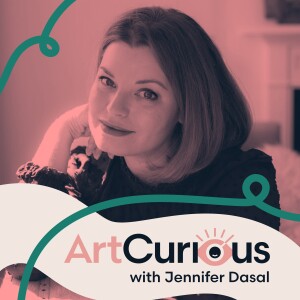
Episode #21: Season Prologue- The Relationship Between Art and War (Season 2, Episode 1)
 2017-07-31
2017-07-31
Download
Right click and do "save link as"
This episode is sponsored by 80Fresh: Get 20% off of your first order by using the code "ARTCURIOUS" here. This episode is also sponsored by Audible: get a free audiobook download and a free 30-day trial here. Thank you for supporting our show!It was the most widespread war in history, involving the participation of more than one hundred million people from around the world, including the greatest powers across the globe: the United States, Great Britain, France, Germany, China, Japan, Italy, and the Soviet Union. It affected life in myriad ways: economically, politically, industrially, scientifically, ideologically. And its reach was one of the most horrible. Between the deaths on the battlefield and the mass killings of civilians, an estimated 50 to 85 million fatalities occurred, making it the deadliest conflict in all of recorded human history. And yet, at the same time, it spurred on glimpses of positivity in the midst of this darkness: giving rise to the so-called Greatest Generation, and leading to advances in medicine and aviation, in information technology, and many other sectors.This was World War Two. But what did the war have to do with art? And how are the effects of the war still being felt today?// Please SUBSCRIBE and REVIEW our show on iTunes.Twitter / Facebook/ Instagram
ArtCurious is sponsored by Anchorlight, an interdisciplinary creative space, founded with the intent of fostering artists, designers, and craftspeople at varying stages of their development. Home to artist studios, residency opportunities, and exhibition space Anchorlight encourages mentorship and the cross-pollination of skills among creatives in the Triangle.Episode CreditsProduction and Editing by Kaboonki Creative. Theme music by Alex Davis. Research assistance by Stephanie Pryor. Social media assistance by Emily Crockett. "The heaven is far" by Damiano Baldoni is licensed under BY 4.0; "machinery" by Kai Engel is licensed under BY-NC 4.0; "aspirato" by Kai Engel is licensed under BY-NC 4.0; "бить настоящим" by Kosta T is licensed under BY 4.0; "Dancing Sparrows A (ID 609)" by Lobo Loco is licensed under BY-NC-NC 4.0; "world of ruin" by Damiano Baldoni is licensed under BY 4.0
The Alexander Mosaic, by Philoxenus of Eretria (presumed), 101 BCE, 272 cm × 513 cm (8 ft 11 in × 16 ft 9 in), National Archaeological Museum, Naples (since 1843), House of the Faun, Pompeii
Eugène Delacroix, Massacre at Chios, oil on canvas, 1824, The Louvre
Francisco Goya, The Disasters of War, 1810-1820, plate 4: Las mujeres dan valor (The women are courageous). A struggle between civilians and soldiers
Francisco Goya, The Disasters of War, Plate 3: Lo mismo (The same). A man about to cut off the head of a soldier with an axe.
Francisco Goya, The Disasters of War, 1810-1820, plate 62: Las camas de la muerte (The beds of death). A woman walks past dozens of wrapped bodies awaiting burial.
Marcel Duchamp, Fountain, 1917–1917, ceramic
Piet Mondrian, Composition C (No.III) with Red, Yellow and Blue, 1935, Tate Modern © 2007 Mondrian/Holtzman Trust c/o HCR International, Warrenton, VA
Ernst Ludwig Kirchner, Self Portrait as an Artist, 1915, Oil on canvas. Oberlin College, Ohio.
view more
More Episodes
012345678910111213141516171819
Create your
podcast in
minutes
- Full-featured podcast site
- Unlimited storage and bandwidth
- Comprehensive podcast stats
- Distribute to Apple Podcasts, Spotify, and more
- Make money with your podcast
It is Free
- Privacy Policy
- Cookie Policy
- Terms of Use
- Consent Preferences
- Copyright © 2015-2024 Podbean.com




